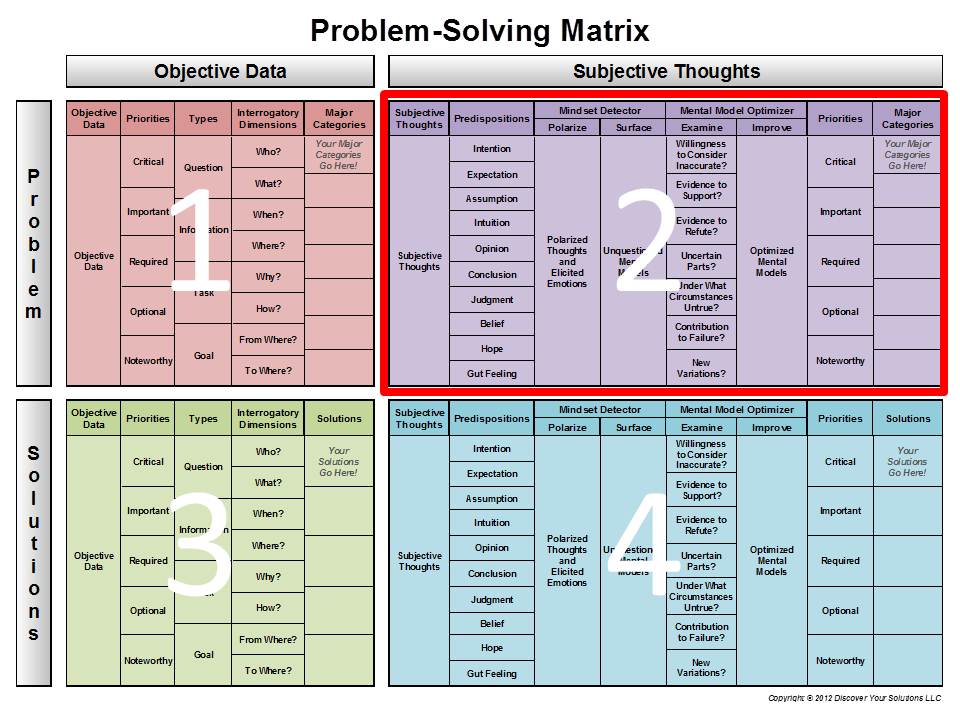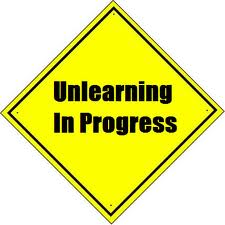Subjective Thoughts - Structuring a System for Analysis
Wednesday, January 15, 2014

Questioning your own thinking is one of the most difficult tasks in problem solving.
If there happens to be flaws in your thinking that are preventing you from solving your problem, then fixing those flaws becomes your most critical task.
Here's a quote I like that frames this issue quite well:
"It ain't what you don't know that gets you into trouble. It's what you know for sure that just ain't so." - Mark Twain
For many problems, questioning your own thinking in a strategic and targeted manner may be your only path to success.
Catch-22 Dilemma
It's not unusual for people to see flaws in other people's thinking. But it may be very difficult to see errors in your own thinking. The reason for this is that most of the thoughts that you are predisposed to, reside below your level of awareness. If you have subjective thoughts that are flawed and are also at the heart of your problem, this can be really big trouble for you.

Here's the dilemma you face:
How do you find flawed subjective thoughts if you can't see them?
In-other-words, how can you surface your flawed unquestioned mental models when they are below your level of awareness?
The purpose of my Subjective Thoughts methodology is to solve this dilemma by using innovative techniques to surface, examine, and improve your unquestioned mental models that are at the crux of your problem.
Eureka!!!

This is where the real excitement begins (at least from my point-of-view). In my previous blog post, I've discussed the importance of having a system to organize your Objective Data. This is a necessary and useful process but it may not get you jumping up-and-down screaming, "Eureka!!! I've found it." Analyzing your Subjective Thoughts can get you jumping up-and-down because this is where you'll find your eureka moments.
Being able to analyze your own preconceived personal thoughts for flaws is an incredibly powerful tool. Once you understand how to use my methodology, you can free yourself from the shackles of your own outmoded thoughts.
Is There An Easier Way?

People who are inclined to actively take on their problems, usually have developed their own ways of analyzing and organizing their problem-solving. I encourage people to use the ways that have worked for them in the past before using my Subjective Thoughts analytic techniques. It just makes sense to start by doing what's worked for you in the past.
However, even expert problem-solvers can get stuck on a problem. Interestingly, the more knowledgeable you are about your problem and the smarter you are, the bigger the disasters you can create. That's right! If you're used to solving 99% of your problems, that 1% can really rock your world and lead to catastrophic failure. This is when people can get really frustrated and desperate.
Desperate People - This Blog is for You

It's an inescapable fact that there may be times when the thing that's stopping you from solving your problem is yourself. It's not that you're some kind of masochist. I think it's because you may have flawed unquestioned mental models, residing below your level of awareness, that are driving your behavior.
Your mental models may have been formed many years ago when they were perfectly reasonable. But your thoughts don't change themselves. They remain fixed until you consciously change them. Since we live in a rapidly changing, highly complex, and uncertain world; your mental models may simply have not been surfaced in a while and have become outdated.
Structuring Subjective Thoughts
In this blog post, I'm going to discuss the analytical system I've devised for structuring Subjective Thoughts (boxes #2 and #4 below). It has five structuring elements: Predispositions, Mindset Detector, Mental Model Optimizer, Priorities, and Major Categories. I've discussed Priorities and Major Categories in depth in my previous blog post, so I'll skip them here.
Problem Solving Matrix
Helpful Hint:
If you're looking at this graphic for the first time, I don't expect you to completely understand it at first glance. I know it looks complex but each part is pretty simple. The reason I've presented it here is so you can see an overview of my methodology.

PRINTABLE: Word version of Problem-Solving Matrix.docx (Click link to download Word version).
PRINTABLE: Excel version of Problem-Solving Matrix.xlsx (Click link to download Excel version).
PRINTABLE: PDF version of Problem-Solving Matrix.pdf (Click link to download PDF version).
Predispositions

Predispositions are your personal thoughts that you're predisposed to. These include your: Intentions, Expectations, Assumptions, Intuitions, Opinions, Conclusions, Judgments, Beliefs, Hopes, and Gut Feelings.
It's important to carefully examine your predispositions that are at the crux of your problem. It's possible that one or more of your preconceived notions may be preventing you from solving your problem.
Mindset Detector

Since most of your unquestioned mental models exist below your level of awareness you need a method to bring them to the surface. To be effective, this technique needs to target mental models that are closely related to your problem. My Mindset Detector is designed to surface unquestioned mental models that are in close proximity to your predispositions about your problem.
The key to this technique is to take a predisposition that is pertinent to your problem and split it into its polar opposites. You can do this by creating an extremely positive example and an extremely negative example of your predisposition.
Next, take one of your examples of an extremely polarized predispositions and ask yourself, "How does that make me feel?" Write down your emotional feelings.
Then ask yourself, "I feel that emotion because?" Write down 'the reasons why' you feel the emotion elicited by your polarized predisposition.
These reasons why you feel emotional about your polarized predispositions are your surfaced unquestioned mental models.
Mental Model Optimizer

Mental models remain 'unquestioned' until they are examined and tested. The Mental Model Optimizer is designed to examine, test, and improve your unquestioned mental models.
The Mental Model Optimizer uses some insights from Unlearning Ineffective or Obsolete Technologies by William H. Starbuck.
In his abstract, Prof. Starbuck describes unlearning:
"Often, before they can learn something new, people have to unlearn what they think they already know."
Predisposition Analysis Tool
I've created a form that follows my Subjective Thoughts analytic methodology. You can find this form and instructions in my Predispositions Analysis tool. You can also check out my Problem Solving Matrix, if you're looking for complete problem solving system.
Structuring Your Subjective Thoughts is a Mechanism for Self-Determination
I think much of the time when people get stuck and can't solve their problems (especially long-term problems) it's because of their own inability to surface, examine, and improve their unquestioned mental models.
It's an incredibly liberating experience to know you have a method you can use to examine and correct your own thinking; particularly when your own thinking isn't working for you.
Having the ability to structure your Subjective Thoughts is so much more than just another problem solving tool. It's a powerful method for self-analysis, empowerment, and personal growth.
by Keith Glein, Founder & CEO
